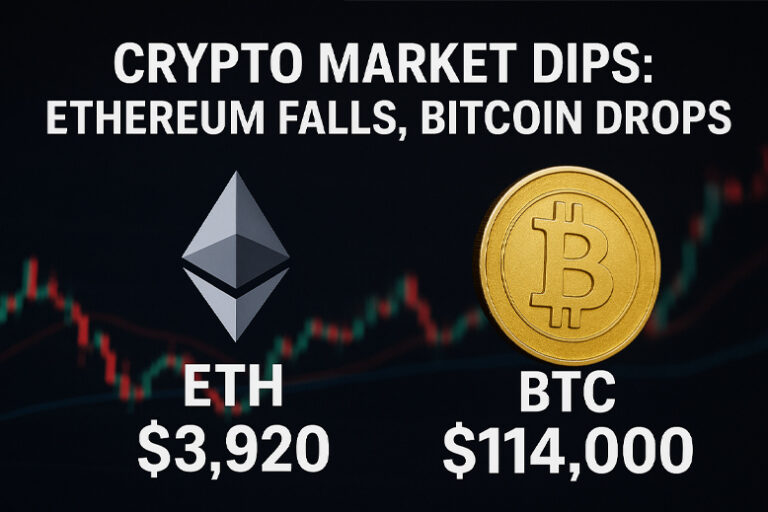Premium Biz Post – The digital asset market has entered a new wave of volatility. Crypto Market Dips has become a major headline among global investors. Both Ethereum and Bitcoin, the two largest cryptocurrencies by market cap, saw sharp declines on October 28, 2025. The Layer-2 sector also dropped by 4.4%. Ethereum (ETH) fell below the key level of US$4,000, while Bitcoin (BTC) slipped to around US$114,000.

This sudden movement raises one big question: is this a short-term correction or the start of a bearish trend?
The Current State of the Crypto Market
Over the past two weeks, the crypto market has shown higher volatility. Prices no longer move in sync with global stock indices like the Nasdaq or S&P 500. Instead, crypto is showing its typical independent behavior, heavily influenced by investor sentiment and institutional activity.
Trading volume on major exchanges such as Binance and Coinbase has surged. This increase signals strong selling pressure from short-term investors. Analysts attribute it to a mix of global macroeconomic factors, uncertainty around U.S. interest rates, and profit-taking after the strong rally earlier in October.
According to Blockchain.News, Layer-2 tokens such as Arbitrum (ARB), Optimism (OP), and Base dropped between 4% and 6% in the past 24 hours. Mid-cap altcoins like Solana (SOL) and Avalanche (AVAX) also declined by over 3% overnight.
Ethereum Falls Below US$4,000
Ethereum had shown strong performance in recent months, supported by growing DeFi and NFT adoption. However, selling pressure is now mounting. On-chain data shows a significant increase in ETH transfers to exchanges — a common signal that investors are preparing to sell.
The drop below US$4,000 marks a critical level. Many analysts previously expected this price to hold as a strong support zone. Yet, sustained selling pushed ETH down to around US$3,920 per coin.
Several factors are driving the decline: rising gas fees, lower Layer-2 activity, and new regulatory concerns in both Europe and the U.S. Despite this, Ethereum’s fundamentals remain strong. The recent Dencun Upgrade, which improves transaction efficiency and reduces costs, continues to boost long-term optimism.
Bitcoin Slips to US$114,000: Healthy Correction or New Downtrend?
Bitcoin remains the key barometer for the entire crypto market. After approaching US$120,000 earlier in October, BTC has since dropped to US$114,000.
While this fall looks significant, many analysts still consider it a “healthy correction.” Benzinga Crypto Analysis reported that Bitcoin could rebound toward US$130,000–US$143,000 if it breaks the resistance level at US$118,000. However, if selling pressure persists, BTC might test support near US$110,000 before stabilizing.
Some large investors — known as whales — have been moving their BTC to cold wallets. This move is widely interpreted as a long-term holding strategy, not panic selling. It suggests that major players continue to have confidence in Bitcoin’s long-term potential.
External Factors: Global Economy and Monetary Policy
The crypto market’s downturn is closely linked to global economic conditions. Investors are waiting for the Federal Reserve’s next interest rate decision. Higher interest rates typically reduce demand for risk assets like cryptocurrencies.
In addition, the strengthening U.S. dollar and ongoing geopolitical tensions in the Middle East add further pressure. Many global investors are shifting funds into safe-haven assets such as gold and government bonds.
Still, the current crypto market is more mature than it was in 2018 or 2022. Infrastructure is stronger, regulations are clearer, and the number of active users continues to grow. These developments could provide a solid foundation for the next recovery phase.
Reactions from the Community and Retail Investors
Social media is buzzing with debates about where the market is heading. Some community members believe this is only a short-term pullback before the next rally. Others warn that the excitement in early October created a mini bubble that is now bursting.
Retail investors, particularly in Southeast Asia, remain active. On platforms like Indodax and Tokocrypto, trading volume is increasing, especially in stablecoins such as USDT and USDC. This shows that many traders are moving funds to safety while waiting for market confirmation.
Long-term investors, however, see this correction as an opportunity to buy at lower prices. Similar patterns appeared in 2023 and 2024 — sharp declines followed by strong rebounds in the months that followed.
Market Outlook and Strategy Ahead
Analysts expect crypto volatility to remain high until the end of Q4 2025. Several key factors will shape the next market direction:
- Federal Reserve Interest Rates
If rates remain steady, risk assets like crypto may see a gradual rebound. - Institutional Adoption
Several major European banks are developing crypto-based ETF products. These could drive fresh demand and legitimacy. - Regulatory Progress
France and the European Union are reviewing new cryptocurrency adoption frameworks. Pro-innovation policies could provide a strong market boost. - Layer-2 Scalability
Networks like Arbitrum, Polygon, and Optimism are improving transaction speed and lowering costs. If successful, user adoption may surge again.
For now, experts recommend a cautious approach. Avoid emotional decisions and consider using a Dollar Cost Averaging (DCA) strategy. This method helps spread risk during volatile periods and allows investors to accumulate steadily over time.
A Natural Market Adjustment
This correction is not the end of the bull run but rather a natural part of the market cycle. Ethereum’s fall below US$4,000 and Bitcoin’s dip to US$114,000 serve as a reminder that volatility is inherent to crypto investing.
In the long run, blockchain technology, decentralized finance, and global adoption remain strong pillars of growth. The true value of crypto lies not only in its price but in its innovation and real-world utility.
Investors should monitor key indicators such as trading volume, Bitcoin’s hash rate, and the number of active wallets. These metrics offer insights into market health and potential trend reversals.
Today’s correction could be tomorrow’s opportunity. A resilient crypto market isn’t one without downturns — it’s one that recovers stronger after every shake-out. With discipline and research, smart investors can turn volatility into long-term advantage.



